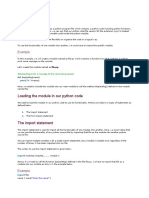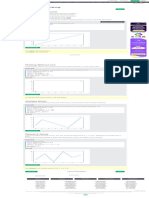Python Modules
Uploaded by
ahmed salemPython Modules
Uploaded by
ahmed salem Tutorials Exercises Get Certified Services Bootcamps Spaces Sign Up Log in
Dark mode
Dark code
HTML CSS JAVASCRIPT SQL PYTHON JAVA PHP BOOTSTRAP HOW TO W3.CSS C C++ C# REACT R JQUERY DJANGO
Python Data Types
Python Numbers ADVERTISEMENT
Python Casting
Python Strings
Python Booleans
Python Operators
Python Lists
Python Tuples
Python Modules
Python Sets
❮ Previous Next ❯
Python Dictionaries
Python If...Else
Python While Loops
Python For Loops What is a Module?
Python Functions
Python Lambda Consider a module to be the same as a code library.
Python Arrays
A file containing a set of functions you want to include in your application.
Python Classes/Objects
Python Inheritance
Python Iterators
Python Polymorphism Create a Module
Python Scope
To create a module just save the code you want in a file with the file extension .py :
Python Modules
Python Dates
Python Math
Python JSON
Example Get your own Python Server
Python RegEx Save this code in a file named mymodule.py
Python PIP
def greeting(name):
print("Hello, " + name)
Use a Module
Now we can use the module we just created, by using the import statement:
Example
Import the module named mymodule, and call the greeting function:
COLOR PICKER
import mymodule
mymodule.greeting("Jonathan")
Run Example »
Note: When using a function from a module, use the syntax: module_name.function_name.
Variables in Module
The module can contain functions, as already described, but also variables of all types (arrays, dictionaries, objects etc):
Example
Save this code in the file mymodule.py
person1 = {
"name": "John",
"age": 36,
"country": "Norway"
}
Example
Import the module named mymodule, and access the person1 dictionary:
ADVERTISEMENT
import mymodule
a = mymodule.person1["age"]
print(a)
Run Example »
ADVERTISEMENT
Naming a Module
You can name the module file whatever you like, but it must have the file extension .py
Re-naming a Module
You can create an alias when you import a module, by using the as keyword:
Example
Create an alias for mymodule called mx :
import mymodule as mx
a = mx.person1["age"]
print(a)
Run Example »
Built-in Modules
There are several built-in modules in Python, which you can import whenever you like.
Example
Import and use the platform module:
import platform
x = platform.system()
print(x)
Try it Yourself »
Using the dir() Function
There is a built-in function to list all the function names (or variable names) in a module. The dir() function:
Example
List all the defined names belonging to the platform module:
import platform
x = dir(platform)
print(x)
Try it Yourself »
Note: The dir() function can be used on all modules, also the ones you create yourself.
Import From Module
You can choose to import only parts from a module, by using the from keyword.
Example
The module named mymodule has one function and one dictionary:
def greeting(name):
print("Hello, " + name)
person1 = {
"name": "John",
"age": 36,
"country": "Norway"
}
Example
Import only the person1 dictionary from the module:
from mymodule import person1
print (person1["age"])
Run Example »
Note: When importing using the from keyword, do not use the module name when referring to elements in the module.
Example: person1["age"] , not mymodule.person1["age"]
Test Yourself With Exercises
Exercise:
What is the correct syntax to import a module named "mymodule"?
mymodule
Submit Answer »
Start the Exercise
❮ Previous Log in to track progress Next ❯
ADVERTISEMENT
ADVERTISEMENT
Spaces Upgrade Newsletter Get Certified Report Error
Top Tutorials Top References Top Examples Get Certified
HTML Tutorial HTML Reference HTML Examples HTML Certificate
CSS Tutorial CSS Reference CSS Examples CSS Certificate
JavaScript Tutorial JavaScript Reference JavaScript Examples JavaScript Certificate
How To Tutorial SQL Reference How To Examples Front End Certificate
SQL Tutorial Python Reference SQL Examples SQL Certificate
Python Tutorial W3.CSS Reference Python Examples Python Certificate
W3.CSS Tutorial Bootstrap Reference W3.CSS Examples PHP Certificate
Bootstrap Tutorial PHP Reference Bootstrap Examples jQuery Certificate
PHP Tutorial HTML Colors PHP Examples Java Certificate
Java Tutorial Java Reference Java Examples C++ Certificate
C++ Tutorial Angular Reference XML Examples C# Certificate
jQuery Tutorial jQuery Reference jQuery Examples XML Certificate
FORUM | ABOUT
W3Schools is optimized for learning and training. Examples might be simplified to improve reading and learning. Tutorials, references, and examples are constantly reviewed to avoid errors, but we
cannot warrant full correctness of all content. While using W3Schools, you agree to have read and accepted our terms of use, cookie and privacy policy.
Copyright 1999-2023 by Refsnes Data. All Rights Reserved.
W3Schools is Powered by W3.CSS.
You might also like
- Python Modules and Packages - An Introduction - Real PythonNo ratings yetPython Modules and Packages - An Introduction - Real Python22 pages
- A Beginner's Python Tutorial - Importing Modules - Wikibooks, Open Books For An Open WorldNo ratings yetA Beginner's Python Tutorial - Importing Modules - Wikibooks, Open Books For An Open World13 pages
- introduction to python module Preeti aroraNo ratings yetintroduction to python module Preeti arora18 pages
- PP Unit IV Modules, Package and Frameworks Notes For Mc4103No ratings yetPP Unit IV Modules, Package and Frameworks Notes For Mc410337 pages
- pythan-PTT II Question Bank With Answer 1No ratings yetpythan-PTT II Question Bank With Answer 110 pages
- System Programming With Python in LinuxNo ratings yetSystem Programming With Python in Linux81 pages
- Intro To OO Programming For COBOL DevelopersNo ratings yetIntro To OO Programming For COBOL Developers25 pages
- Python Scientific Lecture Notes, Release 2012.3 (Euroscipy 2012)No ratings yetPython Scientific Lecture Notes, Release 2012.3 (Euroscipy 2012)1 page
- Python Machine Learning Linear RegressionNo ratings yetPython Machine Learning Linear Regression1 page
- Python Machine Learning - Logistic RegressionNo ratings yetPython Machine Learning - Logistic Regression1 page
- Python Variables - Assign Multiple ValuesNo ratings yetPython Variables - Assign Multiple Values1 page
- Plant Disease Identification Using A Novel Convolutional Neural NetworkNo ratings yetPlant Disease Identification Using A Novel Convolutional Neural Network44 pages
- 4420180083-RAHMAN MD MAHABUBUR (Data Visualization Project Report)No ratings yet4420180083-RAHMAN MD MAHABUBUR (Data Visualization Project Report)13 pages
- Wilson, R. T. Py6S, A Python Interface To The 6S Radiative Transfer ModelNo ratings yetWilson, R. T. Py6S, A Python Interface To The 6S Radiative Transfer Model11 pages
- 2017 - A Quick Start For The Python Interface To LINGO APINo ratings yet2017 - A Quick Start For The Python Interface To LINGO API5 pages
- 2000_1002_DOC_Advanced Features of AI Coding AssistantsNo ratings yet2000_1002_DOC_Advanced Features of AI Coding Assistants3 pages
- Building Skills in Object-Oriented Design 2.1.1 JavaNo ratings yetBuilding Skills in Object-Oriented Design 2.1.1 Java311 pages
- Download ebooks file Make Python Talk Mark H Liu all chaptersNo ratings yetDownload ebooks file Make Python Talk Mark H Liu all chapters50 pages
- What is Introspection in Python Exactly - Google DocsNo ratings yetWhat is Introspection in Python Exactly - Google Docs2 pages
- The Tip of The Iceberg: 1 Before You StartNo ratings yetThe Tip of The Iceberg: 1 Before You Start18 pages
- Programming For Everybody (Getting Started With Python) - Home - Coursera - 1 PDFNo ratings yetProgramming For Everybody (Getting Started With Python) - Home - Coursera - 1 PDF2 pages






















































































































